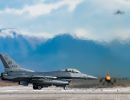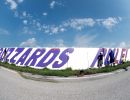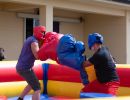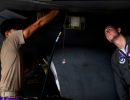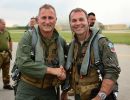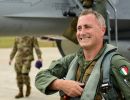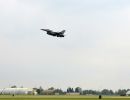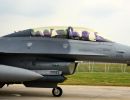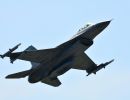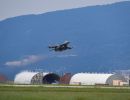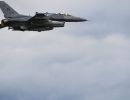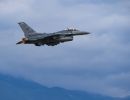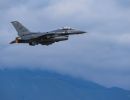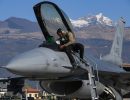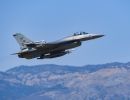Disclaimer
The views expressed in this academic research paper are those of the author and do not reflect the official policy or position of the US government or the Department of Defense. In accordance with Air Force Instruction 51-303, it is not copyrighted, but is the property of the United States government.
Preface
Operation Allied Force gave the Combat Air Forces an opportunity to test its men, women, and equipment in combat, the first of this magnitude since the Gulf War in 1991. This event confirmed the CAF has come a long way between the two conflicts. However, it also highlighted areas for improvement. It is important that we take the time now to assess our performance and consider how we can do it better in the future. After action events are occurring everywhere for just this purpose. What will determine their worth is whether we chart a course to future improvements and steadfastly move in that direction, or whether we just exercise the analysis process and then pay it lip service. I take a special interest in this subject having been assigned to the 31 Fighter Wing and flying numerous Forward Air Controller Airborne missions over Kosovo in support of Operation Allied Force.
I would like to thank all the people who helped me with this research. As a group, the 510 Fighter Squadron and 31 Fighter Wing pilots and leadership formed the basis for much of this work during our 78+ days of preparing for and fighting Operation Allied Force. In particular, I relied heavily on both Maj Pete "Gunz" Gersten and Maj Pat "Smack" McKenzie for ties and information from the operational world. I also want to thank my research advisor, Brig Gen Rosa, for many hours of reading and guidance.
Abstract
The USAF recently put its personnel, training, and equipment to the ultimate test--combat--during Operation Allied Force. During OAF, F-16 Block-40 equipped units flew as Forward Air Controllers Airborne for the first time in major combat operations. This study focuses on what the FAC-As learned from the war and how they can perform better in the next conflict.
By looking at the past and adapting it to the future, one can be more successful. In that light, this paper first lays the foundation by describing applicable events of OAF. These include mission descriptions, training programs, and technology. Next, the research attempts to analyze how the training and technology impacted these missions. Prior to OAF, the 31 FW was well trained in NVGs, night flying, and basic FAC-A procedures. However, they were not adequately trained in the medium altitude autonomous operations they found themselves in over Kosovo. They had also not trained with the Intelligence, Surveillance, and Reconnaissance platforms available during the war. Additionally Higher Headquarters annual requirements were not in line with combat events. Technology also played a role in FAC-A effectiveness. In particular, the targeting pod was not up to the task of finding and identifying targets effectively. The lack of connectivity and real time information in the cockpit was another major technology shortcoming.
This study concludes with recommendations to improve these shortcomings. The recommendations focus on training and technology and are all easily achievable. Since the F-16 will likely be called upon to perform the role of FAC-A many times, it is imperative to learn from the lessons of combat.
Part 1
Introduction
Scenario
"Misty 01 this is Bookshelf, you are cleared to work sector West. The last Forward Air Controller Airborne (FAC-A), Hog 10, reported potential vehicles in a tree line northwest of the town of Pec along with civilian vehicles moving southeast out of Dakovica. We have reports of occasional AAA in all sectors and MANPADS launches from the Pristina and Prizren areas, along with intermittent SA-6 hits 5 nautical miles (nm) northeast of Podujevo. Your on-station assets include Weasel 01 (4 x F-16CJ), Tron 11 (2 x EA-6B), Shooter 31 (2 German ECR Tornados), Speedy 51 (2 x Dutch F-16) holding 20 thousand feet at IP A, Blade 43 (2 x Italian AMX) holding 18 thousand feet at IP A, and Toro 71 (2 x E/F-18) holding 20 thousand feet at IP B. A Predator is working 10-20 nm southwest of Bullseye. You have a 3 nm no-drop area centered on DM 823785. The Combined Air Operations Center (CAOC) directs you to locate and identify the previously mentioned vehicles. Following that, expect further point-outs from JSTARS and Predator." This is just the initial tasking and expectations of a Forward Air Controller Airborne (FAC-A) as he enters the area of responsibility (AOR). The workload only increases in volume, scope, and complexity as the mission proceeds.
Significance of Problem
The USAF combined with its sister services, NATO, and coalition forces recently conducted Operation Allied Force (OAF). The air campaign was broken into two basic fights: air strikes against Serbia proper, and the Kosovo Engagement Zone (KEZ), where all of the FAC-A missions were conducted. The KEZ operations were the first real use of FAC-As integrating a multitude of assets since Desert Storm and the first use of F-16 FAC-As in this magnitude of operations. These KEZ missions proved to be much more difficult than Desert Storm due to factors like terrain, urban areas, non-combatants, and strict Rules of Engagement (ROE). It is very likely that the F-16 Block-40 will be called upon as a FAC-A in future conflicts similar to Kosovo. For that reason it is important to analyze how the F-16 and its pilots performed and determine how things can be done better next time.
Statement of Research Question
This research paper addresses two important questions in the aftermath of Operation Allied Force. First, how did the F-16 Block-40 perform in the FAC-A role over Kosovo? Second, and more importantly, how to improve its performance in future conflicts?
Preview of Argument
The F-16 Block-40 flew extensive combat FAC-A missions for the first time during OAF. The 510th "Buzzards" and the 555th "Triple Nickel" from the 31 Fighter Wing at Aviano AB, Italy, were the units assigned this task. This paper looks at the pilots’ preparation leading up to the conflict and their performance during the KEZ operations. It will show that the pilots found themselves flying missions for which they were neither completely trained or adequately equipped, considering the scenario presented.
The paper will then focus on the more important, forward-looking issue of how to improve future performance. The two areas that will be emphasized are training and technology.
Limitations
Since OAF is still so fresh, very few publications of events exist. For that reason, this research makes extensive use of personal interviews, experiences, and draft reports. Many specifics from OAF along with systems capabilities are classified. Therefore, this paper will use broader, generic data when required. Also, areas like ROE and politics hampered and will continue to impact FAC-A effectiveness. However, these areas lay outside the scope of this paper. Finally, fiscal policies and constraints also impact force structure, but are left for future research.
Part 2
Background and Significance
F-16 FAC-A Mission
Kosovo Area of Responsibility
This AOR made up the southern tip of Serbia and spanned approximately 70 miles across at its widest and longest points. It was bordered by Montenegro on the west, Albania and Macedonia on the south, and Serbia to the east and north. The topography resembled a bowl encircled by mountain ranges. Between the mountains, Kosovo consisted of many urban areas, fields, and woods. The central reference point was Pristina airfield. Some of the major cities included Pristina in the middle, Pec in the northwest, Prizren in the southwest, Urosevac to the southeast, Gnjilane to the east, and Kosovska Mitrovica to the north. As with all of Europe, small rural towns littered the countryside. Many were used as refuges for the Serbian Army and its equipment. Among the threats were MiG-21 aircraft at Pristina airfield, SA-3, SA-6s, Man-Portable Air Defense System (MANPADS), and AAA.
Assigned Aircraft for the Kosovo Engagement Zone
In Kosovo, the F-16 FAC-A controlled the full gambit of US, NATO, and coalition aircraft. This required a great deal of knowledge in what each aircraft brought to the fight and how best to employ these assets. The KEZ packages typically consisted of 40-50 aircraft. Among the strikers were US F-16, F-15E, F-14, F-18, A-10, B-1, B-52, and AC-130 aircraft, and NATO/coalition Dutch, Belgian, and Turkish F-16, Spanish and Canadian F-18, Italian AMX and Tornados, French M2000, Jaguars, and Super Entendard, and British GR-1 and GR-7. The Suppression of Enemy Air Defense (SEAD) aircraft included F-16CJ, EA-6B, ECR Tornados (German), and PA-200H (Italian). The support aircraft included Joint Surveillance, Target Attack Radar System (JSTARS), Rivet Joint, Airborne Battlefield Command and Control Center (ABCCC), and Predator/Hunter Unmanned Aerial Vehicles (UAVs).1
Kosovo Rules of Engagement
The ROE was a function of Combined Forces Air Component Commander (CFACC) mandates combined with political considerations. The KEZ operations ROE constantly changed. "At times, the ROE was very liberal and aggressive, while at others, it was prohibitively restrictive. This ROE, especially KEZ altitude restrictions, combined with the fact that the Serbian forces were well concealed, made target acquisition and identification very difficult."2 Initially, ROE limited the FAC-A to a minimum altitude of 15,000 feet. Eventually the CFACC lowered this to 5,000 feet above ground level (AGL) due to difficulties in target acquisition. Also, the rules governing latitude for what decisions the FAC-A could make regarding target engagement varied throughout the war, generally becoming more restrictive as time went on.
FAC-A Mission Complexity
An awareness of the FAC-A mission complexity is insightful in assessing the adequacy of the training and technology in place prior to Kosovo. The vast and varied task list for a FAC-A begins before he even takes to the skies. He must work with the army ground liaison officer to determine the ground order of battle. Where are the friendlies? Where is the enemy? What will he look like? What are the expected maneuvers for the day? Not only must he be proficient in enemy aircraft visual identification, but also enemy surface forces visual identification. Then the pilot works with the intelligence shop to gather intelligence reports, reconnaissance data, and available imagery. Finally, he fuses all the information with the Air Tasking Order (ATO) assigned assets, ROE, and amplifying data to develop a sound tactical gameplan.
Once airborne, the FAC-A molds his plan to fit the ever-changing current environment. The FAC-A begins by getting a situation update from a Command and Control (C2) agency prior to reaching the AOR. The update includes items like threats, weather, enemy and friendly status, and potential targets, all of which are the FAC-A’s responsibility. After that, the radios are continually alive with his wingman talking to him, C2 and Intelligence, Surveillance, and Reconnaissance (ISR) assets passing updates, SEAD aircraft telling him of threats, the Tactical Air Control Party (TACP) talking him onto targets, and his dedicated strikers talking to him. All the while, he is processing what everyone is saying, continually updating his plan, and insuring the good guys stay alive while punishing the bad guys.
The FAC-A sortie involves many variables. He must locate the friendly forces and non-combatants, particularly difficult if not communicating with them. The responsibility to avoid fratricide rests squarely on the FAC-A’s shoulders. Also, the FAC-A must deconflict ground forces’ artillery and rockets from aircraft in the AOR. The FAC-A continually assesses the threat since he is responsible for determining tactics and flows that will preserve his flight and his assets. As he is doing this, he must also keep track of which fighters are checking in, where they are holding, their ordnance, their playtime, and other pertinent data.
Now that he is in position, the FAC-A must find the target. If a TACP is present, history has shown he can be very useful. Usually, the TACP locates the target first and then works the FAC-A’s eyes on to it. This dialogue can be very laborious, especially as the targets become smaller or more concealed. The vastly differing viewpoints between the TACP’s ground level view compared to the FAC-A’s bird’s eye view, adds to the difficulty. While this task is quite challenging, it becomes significantly tougher without a TACP, as was the case in Kosovo. In this case the FAC-A searches across the AOR trying to find targets based on old imagery, intel reports, or hand-offs. This truly represents the proverbial "finding a needle in a haystack." Even if the FAC-A is fortunate enough to find the "needle," his job isn’t complete. The FAC-A must then determine if it is a friendly or enemy "needle," without a TACP close-up view.
After confirming an enemy target, the FAC-A selects the best available striker for the attack. The FAC-A bases his decision on the best match of aircraft and armament for a particular target, weather conditions, and threat array. If it is time sensitive, the FAC-A element attacks the target. Once he selects the strikers, the FAC-A decides the best route to the target and the best method of attack. As the strikers proceed to the target area, the FAC-A locates them and moves them into a position where he can talk their eyes onto the target. The talk-on might involve using a mark from a rocket or bomb, or toughest of all, using words alone. Once the FAC-A is sure the strikers have acquired the target and are no danger to friendlies, he clears them to expend ordnance. By giving this clearance, the FAC-A takes responsibility for the strikers’ bombs.
After the attack, the FAC-A assess whether the bombs achieved the desired effects. He then either calls in more strikers to service the target, moves on to another target area, or proceeds to a tanker for air refueling, then returns to start the entire process again. During OAF, the normal vulnerability period for the FAC-A was two to three hours, for a total sortie duration of four to five hours. This typical mission becomes even more difficult when adding variables like weather, night, concealment, or non-combatants, which can come into play. 3 Another essence of the FAC-A role is Combat Search and Rescue (CSAR). It is generally expected that the FAC-A will become the On Scene Commander (OSC), at least until relieved by CSAR forces, in the event an aircraft goes down. The FAC-A is a logical choice as OSC since he likely has the most situational awareness of the AOR and is probably the best-trained asset, at the time, for locating and protecting the downed aircrew. The extensive duties of the OSC are beyond the scope of this paper, but rest assured it takes the FAC-A role just described to the next level. It is such an involved mission that the A-10 community specially trains and designates select pilots for the role.
This section has given the reader some understanding of the complexity of the FAC-A role and shed light on the importance of adequate training and equipment. Executing the full realm of a FAC-A mission is not a second-hand ability. It requires dedicated and extensive training combined with mission enhancing equipment.
Significance
While the F-16 FAC-A mission was only one piece in a very involved air operation, it is still significant to analyze and learn from the experience. It is especially important for the F-16 community, and as the fighter workhorse, it also becomes important to the Combat Air Forces (CAF). Until the Joint Strike Fighter fully replaces the F-16 many years from now, the USAF will call upon the F-16 to fulfill the FAC-A role in future conflicts. Many will likely be limited scale operations incorporating urban terrain and non-combatants. The situation becomes even more critical if the National Command Authority authorizes the use of US ground troops. Forces on the ground lead to the challenging scenario of troops-in-contact and the potential to commit fratricide. It is imperative that the FAC-A be masterfully prepared for his role, whether it is simply executing more efficiently to achieve the end-state or holding the fate of non-combatants and friendly troops in his hands.
Notes
1 Tactics Analysis Bulletin (TAB) 99-1, Operation Allied Force Lessons Learned, chapter 4.4.2. (Secret) Information extracted is unclassified.
2 Ibid, chapter 4.1.
3 This is an overview of a typical FAC-A sortie for the 31 FW, recounted by the author, who flew 16 FAC-A sorties during Operation Allied Force. The author was assigned to the 510th Fighter Squadron, Aviano AB, Italy, from over a year before OAF until a month after the peace agreement.
Part 3
F-16 FAC-A Training
Initial Qualification Training
FAC-A training consisted of two phases--initial and continuation. The 310 Fighter Squadron (FS) at Luke AFB conducted the Initial Qualification Training. Students received 11.5 hours of FAC-A specific academics. The academics focused on classic low to medium threat scenarios involving troops on the ground and the FAC-A working with a TACP in a ground war scenario. The academic syllabus did not address self-acquisition and identification of targets, nor did it address the complexities of urban terrain and non-combatants.1 Besides academics, students flew 11 sorties. The sortie composition was eight day and three night missions. As with academics, all sorties resembled the classic FAC-A role with a TACP. None of the missions included a scenario involving the FAC-A finding and identify his own targets or worrying about Military Operations in Urban Terrain. In addition, the program did not integrate any ISR or C2 assets into the training.2
In the case of the 31 FW, once the FAC-A graduate returned to Aviano, he accomplished a two-ride local top-off. The top-off consisted of one day and one night sortie to Bosnia-Herzegovina (B-H). Following these combined 13 rides; the pilot was signed-off as a full-fledged FAC-A.
Continuation Training
Once a pilot finished initial training, he moved on to the realm of continuation training. The goal of continuation training (CT) was to mold the pilot into a combat-ready warrior by practicing and perfecting necessary skills. Prior to OAF, the 31 FW conducted most of its FAC-A continuation training on B-H contingency sorties. Each FAC-A flew a FAC-A sortie in-country at least every other month. The high point of continuation training was their night vision goggle (NVG) program. All the FAC-As were experienced flying at night and with NVGs.
USAFE levied the framework for specific training requirements upon the 31 FW via AFI 11-2F-16, Vol. I, Ready Aircrew Program (RAP). Under these guidelines a FAC-A needed to fly only 10 percent of his annual sorties (10 of 96) in the FAC-A role. At the same time, RAP required these pilots to fly another 10 percent of their sorties (10 of 96) as Basic Surface Attack (BSA) and 8 percent (8 of 96) at low altitude. The Ready Aircrew Program also included weapons delivery requirements. A FAC-A had to fire 18 rockets a year. That was only 12 percent of their 154 air-to-ground requirements3. Unfortunately, Aviano did not have a local range for employing rockets. Therefore pilots typically fired all their rocket shots during 2-3 week weapons training deployments each year. While the annual deployments fulfilled the training requirements, they did not result in sustained proficiency throughout the year. For a few pilots even, OAF was their first time to fire rockets since initial training.
Local training in B-H tended to be very low intensity and low demanding. The 31 FW pilots rarely practiced autonomous operations. Generally, the FAC-A worked with a TACP who had a few pre-planned targets. It was common for the targets to be relatively easy to find. Also, it wasn’t uncommon for the TACP to reuse the same targets on subsequent missions. In addition, when FAC-As practiced urban targets, it was always under the direction of a TACP, who could identify the target and sanitize the area of for non-combatants.4 Finally, each FAC-A generally controlled only a single set of fighters during a mission.
Many ISR platforms operated during contingency sorties, and with prior coordination, could have been used. Predator UAVs, for example, flew multiple missions over B-H. However the 31 FW never pursued training with Predators. Thus, the first experience for any of the FAC-As to work with a unmanned aerial vehicle (UAV) was during OAF.
Finally, there was minimal CSAR and On Scene Commander training for these FAC-As.5 Entering OAF, the extent of 31 FW CSAR and OSC training for most FAC-As was a single academic lesson once a year. Less than 25 percent of the FAC-As had practiced a dedicated CSAR training mission in the previous two years.6
Notes
1AETC Syllabus F16C0FACPL--USAF Forward Air Control (Airborne) Training, F-16 C/D, January 2000, Paragraph 3.5-3.6.
2 Ibid, Paragraph 5-1.
3 USAFE F-16 Block-40 Ready Aircrew Program (RAP), Supplement to AFI 11-2F-16, vol. 1, 1 October 1999, 1-3.
4 TAB 99-1, Annex N. Paragraph 12.9. (Secret) Information extracted is unclassified.
5 Ibid, Paragraph 14.1. (Secret) Information extracted is unclassified.
6 Maj Patrick McKenzie, 510th Fighter Squadron, Aviano AB, Italy, Member of Nellis AWOS Lessons Learned Conference. Interviewed by author, 10 December 1999.
Part 4
F-16 Block-40 Technology
Hardware
A look at aspects of the F-16 Block-40 technology provides insight into its capabilities and limitations while performing the FAC-A role during OAF. This paper discusses three sets of hardware used by the FAC-A, the night vision system, the targeting pod system, and the self-protection system. The 31 FW possessed top of the line NVGs, which illuminated the world outside the aircraft, even on the darkest of nights. 1 Combined with the NVGs, the wing was the only operational unit to have the Night Vision Imaging System (NVIS) cockpit modification, which made all the cockpit lighting "NVG-friendly." The NVIS modification enhanced the use of NVGs by not flooding them with bright aircraft lights, allowing the pilot to better see both inside and outside. The modification also allowed pilots to use covert external lighting, which blacked out the bottom side of the aircraft and made the top lights visible only with NVGs.
The targeting pod was the most frequently used piece of hardware during OAF. It was an infrared (IR) device that used temperature differentials to display an IR picture on a 4" x 4" multi-function display (MFD) to the pilot. The targeting pod (TGP) had no electro-optic (EO) capability. The TGP had three fields of view, wide field of view (WFOV), narrow field of view (NFOV), and expand field of view. Changing the FOV increased the magnification but did not change the resolution. The WFOV and NFOV yielded a 6.0 x 6.0-degree and 1.7-x 1.7-degree field of regard respectively. On a low altitude identification pass at 5,000 feet and 2 nm slant range it presented a picture size of 1274’(w) x 3138’(l) in WFOV, and 361’(w) x 877(l)’ in NFOV.2,3 This small picture is commonly referred to as a "soda straw" view, especially at night when most other visual references are absent. The TGP system displayed the image on a small multi-function display situated by the pilot’s knee. These small displays were less than 12 percent of the viewing size of a standard 15" computer screen. Finally, the TGP had a laser designator for guiding LGBs or marking targets for specially equipped aircraft or ground troops.
While the TGP possessed many capabilities, some potential features were absent. The first such capability was a laser spot tracker (LST). A LST would have placed a symbol on the TGP video showing laser illumination. The FAC-A could have programmed the tracker to discriminate between various lasers. Another characteristic was the inability to play back video in-flight. With this capability the FAC-A could have replayed previous TGP video on his multi-function display for target recognition and identification.
The final hardware element was the self-protection expendables system. The F-16 Block-40 could only carry a total of 120 chaff (in 30 bundles sets), or 60 flares (in 15 bundle sets), or a combination of the two. During OAF the standard load was 60 chaff and 30 flares. The chaff was used against radar-guided threats, of which the early warning, SA-3, SA-6, and air interceptor radars were a factor in Kosovo. Flares meanwhile, were used in defense of infrared threats, primarily the SA-7/14 MANPADS in Kosovo. Typical threat reactions used 12-18 bundles of chaff or 5-10 flares. Of note, while chaff was invisible to the naked eye, the F-16’s flares were extremely bright and can be easily seen.
Connectivity
Along with hardware, this paper also looks at the F-16 avionics connectivity. The 31 FW aircraft had the most current avionics software tape, Operational Flight Program (OFP) Tape-5. Along with the avionics upgrade, the 31 FW also received an Improved Data Modem (IDM), giving the aircraft some rudimentary connectivity with other platforms. The IDM could interrogate other like-equipped F-16s and show the position of up to three of them on the multi-function display. In addition, the IDM could receive a detailed CAS message from a TACP (or C2 platform), which included target, threat, and descriptive information, however it could not pass the same message along to other aircraft or generate its own message to transmit.4 On the downside of connectivity, the F-16 could not make use of any other critical real time information in the cockpit (RTIC). The FAC-A could not receive any data or imagery from C2, ISR, or national assets. Additionally, it could not send any of its imagery or data to other aircraft or C2 assets.
Notes
1 NVGs provide a restricted view of the world by enhancing low light levels several thousand times. They produce a green and black image for the pilot to observe. They have no magnification and can be tuned to nominal 20/30 vision using equipment in the squadron. The field of regard is almost equivalent to looking through two toilet paper tubes.
2 31st Operations Group, Weapons Attack Guide (WAG), January 1999, 7-9.
3 Ibid. In addition to WFOV and NFOV, the TGP ahs an "expanded" FOV that doubles the NFOV picture size by using a digital video expansion. The TGP magnifies the image electronically, but does not improve resolution. In all FOVs, the pilot is able to perform crude focusing, but it only applies to that particular FOV and focus distance, 7-9.
4 The Pilot’s Guide (F-16 C/D Block 40/42 Production Tape No 5). Lockheed Martin Tactical Aircraft Systems, 15 Jun 1998, 9-11.
Part 5
Analysis
Initial Qualification Training
Conducting a formal, central, FAC-A school for initial training is good for the CAF. The level of support by the USAF will be the biggest determinant to the quality of the program. If the USAF does not allocate the necessary resources, the result will be inadequate training. For example, a benefit to having a dedicated school is it limits the need for local initial upgrades. These upgrades place a large demand on local flying operations, which should instead focus on continuation training. However, units in the field have complained that needed training slots are not always available, requiring them to perform local upgrades.1 Another area for improvement is to develop and teach more realistic scenarios. Currently, both the ground and flying training focus on classic low to medium threat scenarios involving troops on the ground and the FAC-A working with a TACP in a ground war scenario.2 While that is certainly important, it is by no means complete. None of these mission scenarios involve the FAC-A finding and identifying his own targets or worrying about Military Operations in Urban Terrain such as the Kosovo operations. Finally, the program is remiss by not requiring students to work with any ISR or C2 assets.3
Continuation Training
Certainly initial training is important to lay a foundation for future development, but pilots really hone their skills by continuation training. Combat capability is directly related to the investment in CT. The 31 FW CT program prior to OAF had a couple high points. First, each FAC-A flew missions into B-H during contingency tasking. This gave the pilots a chance to become more familiar with the terrain and maintain a minimum level of currency. The 31 FW also placed a high emphasis on their night vision goggle program. The FAC-As, in part because most were also instructors, were the most experienced NVG pilots in the wing. Since Aviano performed all the night FAC-A missions for the USAF, this skill was imperative. It would have been impossible and unsafe for a non-NVG qualified FAC-A to fly one of these missions.
Just as there were high points, the continuation training program also had deficiencies. The first area involved the amount of training dedicated to FAC-A sorties. As discussed earlier, the Ready Aircrew Program required only 10 percent of the annual sorties be FAC-A missions. Yet during OAF, these pilots flew over 50 percent of their sorties as a FAC-A.4 Accentuating that disparity, RAP required pilots to fly another 10 percent of their sorties as Basic Surface Attack and 8 percent at low altitude. Referring back to OAF, the primary bomb for the FAC-A was an LGB and no pilot ever flew a low altitude sortie. Another RAP requirement, which was out of line with combat employment, was the rocket weapons delivery requirement. Under RAP, rocket deliveries were only 12 percent of their annual weapons requirements. Yet FAC-A's used rockets as their primary method of marking targets during combat.5
Another training shortcoming was that FAC-As did not practice realistic scenarios like they faced during OAF missions. Instead, the B-H training sorties were very simplistic. The FAC-A worked with a TACP who usually selected easy to find targets. The mission concluded with the FAC-A controlling a single set of fighters onto the target. The first thing missing was practicing autonomous operations. The pilots were unprepared to locate and identify a target without the aid of a TACP. The ability to discover a Serbian Army vehicle and then discern it from a non-combatant vehicle was the single biggest detractor to mission success during OAF. According to after action reports, the search for targets was 95 percent of the tactical problem in the KEZ.6 Another recurring OAF characteristic was locating targets in urban environments interspersed with non-combatants. However, the vast majority of practice missions were flown against targets away from villages. When FAC-As did practice urban targets, they always had a TACP who could sanitize the area of for non-combatants.7
The lack of integrating with ISR assets was another training deficiency. The potential existed to work these assets into continuation training during contingency sorties. For example, Predator UAVs flew multiple missions over B-H at the same time as 31 FW pilots, however the unit did not conceive of practicing UAV search and CAOC directed talk-ons for the FAC-A. During OAF Predator/Hunter UAVs, JSTARS, Rivet Joint, and other national assets were constantly available, yet the FAC-A didn’t understand all their capabilities and limitations or how best to use them. The ISR assets were equally unprepared to aid the FAC-A with their wealth of information. Results from one particular OAF mission highlight the ISR capability. A Predator detected an SA-6 Launcher inside a tree line. The CAOC passed the approximate location through ABCCC to the FAC-A. The FAC-A proceeded to the designated area and then worked a talk-on directly with the UAV observer sitting at the CAOC in Vicenza, IT. The talk-on included the FAC-A marking the target area with rockets for the CAOC observer, who then used the marks to walk the FAC-A’s eyes onto the SA-6. The site was then promptly destroyed.8
Unfortunately, this example was indeed a rare case, vice the norm, due to limited proficiency by pilots and observers working together.
The final training deficiency lay in the area of CSAR and On Scene Commander training.9 Prior to OAF, the 31 FW did not have dedicated CSAR and OSC training for FAC-As. In fact, less than 25 percent of the pilots had even flown a dedicated CSAR training mission in the previous two years.10 It was simply a blessing that the coalition did not have an aircraft go down during KEZ operations. Had one gone down, the FAC-A would have been expected to become the OSC.11 The foundation for a successful or unsuccessful rescue operation is built upon practicing for this misfortune. The role was too complex and too important for the FAC-A to not be experienced and knowledgeable in its conduct.
Hardware
While training is important, it alone cannot ensure success. To excel at the mission, the F-16 FAC-A must also leverage available technology. The hardware used by the FAC-A over Kosovo had both its pluses and minuses. The 31 FW’s night vision devices were a grand success story. 12 Since the 31 FW flew the vast majority of their missions at night, they would not have been effective without NVGs. Night vision goggles helped the pilot stay spatially oriented by viewing the ground and horizon, instead of studying gauges. In addition, with NVGs pilots could detect vehicle movement with even the dimmest of lights. The pilot also used NVGs to translate images from their larger field of regard into the more restricted TGP picture. However, NVG acuity and resolution wasn’t sharp enough to distinguish between vehicles at every tactical altitude. Finally, night vision goggles were also outstanding aids for acquiring anti-aircraft artillery and surface to air missile (SAM) launches. Most pilots reported better threat acquisition at night than during the day.13
The targeting pod was the most used piece of hardware during OAF, but unfortunately it was also the single biggest hardware deficiency reported by the pilots. The most glaring limitation was the inability to clearly identify targets.14 The TGP was originally used to attack fixed interdiction targets with LGBs. On that type mission, pilots studied target imagery in detail prior to takeoff and even carried target photos with them in the air. Approaching the target area, pilots worked off major funneling features, which showed up well in the TGP, to acquire the actual target. Another advantage to these interdiction sorties was that an analyst had already determined the target validity. In Kosovo however, the FAC-A had to find targets without pre-mission imagery. He also had to determine target validity himself. In order to do that, he had to be able to distinguish an Army vehicle from a non-combatant vehicle. The small size and location of the MFD accentuated the lack of TGP resolution. It was common during mission debriefs to find and identify targets on the FAC-A videotape when it was viewed on a 35" television. This task proved almost impossible while flying the aircraft at the initial ROE minimum altitude of 15,000 feet MSL. Several nights of minimal engagements drove the 31 FW/CC to recommend a lower minimum altitude of 5,000 feet AGL. The wing forwarded this request to the CFACC who approved the lower altitude.15 Yet even at 5,000 feet FAC-As had difficulty positively identifying vehicles. The low TGP resolution combined with the approved lower minimum altitude resulted in FAC-A doing low altitude passes in the heart of the AAA and MANPADS envelope with his head buried in the MFD trying to identify targets.
In addition to the difficulty in identifying targets, two other TGP deficiencies stand out. The first was the absence of a laser spot tracker. This would have allowed the FAC-A to either visually confirm that laser capable strikers indeed had the correct target or work target point outs from a laser equipped UAV or ground based laser designator. Ultimately, the increased target assurance provided by a laser spot tracker could reduce the chance of fratricide or collateral damage.16 The other deficiency was that the TGP video could not be played back in flight. This capability would have reduced the FAC-A’s workload and increased his target identification. Rather than overfly the target at night with his head buried in the MFD, the FAC-A could have kept his head outside the cockpit looking for threats and maintaining situational awareness while recording the pass with the TGP. Then he could have climbed up, moved to a safer location, and played back his target pass on the MFD. He could then concentrate on identifying the target, even freezing the video if he needed to study it.17
The final element of hardware to analyze is the self-protection expendables on the F-16. As discussed earlier, the F-16 was very limited in the number of expendables available. With typical defensive reactions, these quantities could be expended quickly. Due to proliferation, MANPADS were present throughout the AOR. The best method to defeat these was to dispense flares. However, the short time of flight for these missiles made reactive flares very unlikely. It was more effective to use a string of preemptive flares to decoy or deny the missile shot but two problems accompany preemptive flares. First, it required many flares, possibly 5-10 flares per pass. This rate limited a FAC-A to only 3-6 protected passes per sortie. The other problem was that they highlighted the aircraft. One advantage the F-16 had was its small size and difficulty being spotted. But as soon as it dispensed flares, everyone saw it. Highlighting the jet exposed it to AAA or follow-on MANPADS. An example of the limited chaff expendables occurred on one early KEZ mission, when an SA-3 and associated target acquisition radars illuminated a FAC-A element numerous times. Taking a defensive posture, the FAC-A wingman expended all his chaff during the first 30 minutes of a two-hour vulnerability window. The FAC-A on the other hand, chose to ration his expendables, which increased his exposure. Neither of these options was optimal for force survival.18
Connectivity
Besides hardware, the other major area of technology that needs to be leveraged is connectivity. By far the biggest software technology limitation was the lack of real time information in the cockpit. An abundance of C2, ISR, and national assets were available during OAF, yet not once did they pass data, other than via word of mouth, to a FAC-A. According to US officials, "US forces remain unable to instantaneously provide ‘shooters’ with intelligence gathered by the plethora of allied surveillance and reconnaissance assets and spy satellites."19 The possibilities were staggering and the enhancement to mission effectiveness remarkable. As the adage goes, "a picture is worth a thousand words." Unfortunately during OAF, the FAC-A had to use the thousand words and then some. The ideal flow would have been for an ISR platform to detect a target, an analyst validates the target, and then C2 down-link the image and associated details (i.e. description and location) into the FAC-A cockpit. The FAC-A could then have proceeded to the new target and in moments, using the new data in his jet, find, fix, and destroy the target.
To illustrate the value of RTIC, recall the scenario where the CAOC, using video from a Predator, talked the FAC-A onto the SA-6 in the tree line. This process took an excessive amount of time. The CAOC attempted to talk a previous FAC-A onto the target for nearly 15 minutes. That FAC-A eventually reached bingo fuel and had to depart without acquiring the target. The second FAC-A element then proceeded to the target area and required almost 10 minutes to find, fix, and destroy the SAM. Imagine if the CAOC had transmitted Predator imagery of the SA-6 into the FAC-A’s cockpit. The FAC-A could then have matched the imagery to what he was seeing with his eyes and through the TGP. Instead of requiring two FAC-A elements over 25 minutes, the target could have been destroyed in just minutes. This was extremely critical considering the fact that throughout those 25 minutes, the FAC-A elements were in the heart of that SA-6’s lethal engagement envelope.20 In addition to benefiting from received imagery, the FAC-A would have more effectively directed strikers onto targets, while avoiding fratricide or collateral damage, if he could have sent them captured TGP imagery.
Besides imagery, the command and control net could have provided other essential data to the FAC-A. They could have passed updates to the ATO, fighter check-in data, and other administrative information. Threat information is another piece of critical data that could have been sent to the FAC-A. He could then have viewed the threats on his situation display inside the cockpit. This would have increased his situational awareness and possibly force survival. Data-linked information would decrease radio transmissions over already saturated frequencies. It would also alleviate the FAC-A from having to stop what he was doing and write down the information or store it in his short-term memory while he was in the middle of numerous other tasks.
AWOS Lessons Learned Conference. Interviewed by author, 10 December 1999. 11 TAB 99-1, Annex N, Paragraph 14.2. (Secret) Information extracted is unclassified. 12 The 31 FW’s night vision devices included both night vision goggles and the night vision imaging system lighting. 13 McKenzie. 14 TAB 99-1, Annex N, Paragraph 8.6.5. (Secret) Information extracted is unclassified. 15 McDaniels, Personal recount by author of meeting with 31 FW/CC on 15 Apr 1999. 16 TAB 99-1, Annex N, Paragraph 13.1. (Secret) Information extracted is unclassified. 17 Gersten. 18 McDaniels, Personal account of mission flown 29 May 1999. 19 Bender, Bryan. "Allies Still Lack Real-Time Targeting." Janes Defence Weekly, 7 April.
Notes
1 Maj Peter Gersten, Squadron Weapons Officer, 310th Fighter Squadron, Luke AFB, AZ, Interviewed by author, 5 January 2000.
2AETC Syllabus F16C0FACPL--USAF Forward Air Control (Airborne) Training, F-16 C/D, January 2000, Paragraph 3.5-3.6.
3 Ibid, Chapter 5.
4 Data collected by reviewing flight records from the 510th Fighter Squadron.
5 USAFE F-16 Block-40 Ready Aircrew Program (RAP), Supplement to AFI 11-2F-16, vol. 1, 1 October 1999, 1-3.
6 Tactics Analysis Bulletin (TAB) 99-1, Operation Allied Force Lessons Learned, chapter 4.1.1.2. (Secret) Information extracted is unclassified.
7 Ibid, Annex N, Paragraph 12.9. (Secret) Information extracted is unclassified.
8 Maj Jeff McDaniels, Personal description by author of mission flown 29 May 1999.
9 TAB 99-1, Annex N, Paragraph 14.1. (Secret) Information extracted is unclassified.
10 Maj Patrick McKenzie, 510th Fighter Squadron, Aviano AB, Italy. Member of Nellis AWOS Lessons Learned Conference. Interviewed by author, 10 December 1999.
11 TAB 99-1, Annex N, Paragraph 14.2. (Secret) Information extracted is unclassified.
12 The 31 FW’s night vision devices included both night vision goggles and the night vision imaging system lighting.
13 McKenzie.
14 TAB 99-1, Annex N, Paragraph 8.6.5. (Secret) Information extracted is unclassified.
15 McDaniels, Personal recount by author of meeting with 31 FW/CC on 15 Apr 1999.
16 TAB 99-1, Annex N, Paragraph 13.1. (Secret) Information extracted is unclassified.
17 Gersten.
18 McDaniels, Personal account of mission flown 29 May 1999.
19 Bender, Bryan. "Allies Still Lack Real-Time Targeting." Janes Defence Weekly, 7 April 1999, 63.
20 McDaniels, Personal account by author of mission flown on 13 April 1999.
Part 6
Conclusion
Summary of Findings
This paper has looked at F-16 Block-40 Forward Air Controllers Airborne. As a foundation, the effectiveness and lessons learned from the 31 FW during Operation Allied Force were discussed. This foundation provided a springboard to the heart of the issue—how to improve performance in future conflicts.
In conducting the research, several mission shortfalls surfaced and tended to gravitate towards two broad categories--training and technology. The level of training for the FAC-A entering the war was insufficient. Beginning with initial qualification training, pilots did not practice realistic scenarios similar to Kosovo. The instruction focused primarily on a classic ground war with a FAC-A supporting the Army and working with a TACP. The wing’s continuation training program also had deficiencies. Like IQT, this program did not recognize the type of scenario that presented itself in Kosovo. Pilots did not train in medium altitude self-acquisition and identification of targets; the most challenging aspect of the FAC-A mission during OAF. Also, the wing made no attempts to integrate and work with the UAVs or other ISR assets that were continuously operating during B-H contingency sorties.1
Some of the training deficiencies were attributed to Higher Headquarters (HHQ) directives in the form of Ready Aircrew Program requirements. The RAP requirements in place put as much or more emphasis on historical low altitude general-purpose warfare, as it did on the FAC-A missions flown in OAF.2 The examples indicate that HHQ training requirements may be misaligned with combat mission requirements.
The final training issue was the omission of recurring and dedicated training or requirements in CSAR. In the unfortunate event that an aircraft had gone down, the FAC-A would have been expected to be a competent On Scene Commander. Had a fellow airman’s life rested in the FAC-A’s hands, it would have been too late to realize he was ill prepared to meet the challenge.
Training was not the only weakness; numerous technology limitations also surfaced. The most glaring hardware limitation was in the TGP capabilities. The resolution capability was inadequate to identify targets from the CFACC desired 15,000 foot altitude restriction. The inability to identify targets resulted in the FAC-A having to fly down to 5,000 feet AGL, significantly increasing his exposure to threats. The pilot also lacked several beneficial TGP features such as a laser spot tracker and in-flight video playback.
Another hardware limitation discovered was the low number and characteristics of self-protection expendables carried by the F-16. The previously mentioned TGP limitations drove the FAC-A down into several threat envelopes with a great deal of his focus inside the cockpit. An improved self-protection capability would have made the FAC-A more survivable. To make things worse, with the limitations at that time, the FAC-A had to both ration his expendables and fear that using them preemptively would highlight the aircraft.
A final technology deficiency found, was the inadequate connectivity of the F-16. By far the biggest problem was the lack of RTIC capability for the FAC-A. Many off-board C2, ISR, and national assets operated during OAF, but not once did they down-link information to the FAC-A. This omission greatly hampered FAC-A mission effectiveness. Besides receiving data, the FAC-A was also limited by what information he could send to others. In particular, he had no capability to transmit TGP imagery.
The FAC-As from Aviano did a fine job for what they were trained and equipped for, but they certainly didn’t drive the Serbian Army from Kosovo. They were probably successful in harassing the army, but that was about all. Will the CINCs of future conflicts demand and expect more? That answer should drive the emphasis in improving the F-16 FAC-A capability.
Recommendations
In light of the findings of this research, a few recommendations are offered. These recommendations focus on the areas of improved training and enhanced technology. While making technology recommendations, no attempt is made to promote any particular supplier. Also, the author has limited the scope of technology recommendations to those available at this time. Current research and development may have systems that can further enhance these recommendations.
TRAINING
Overall, training needs to better address the realistic scenarios that a FAC-A may encounter. Improved training should be embodied in both initial and continuation training, realizing that CT is the real moneymaker. Specific training suggestions include:
Maintain a single, central schoolhouse (currently the 310 FS at Luke AFB). A central school will allow initial upgrade training plan development by a dedicated staff and a specific repository for lessons learned. This school will need sufficient funding and USAF support to meet the needs of the field. Central initial qualification training will reduce the burden of upgrade sorties on operational squadrons, allowing them to focus more on needed continuation training. The staff should work with the FAC-A units in the field to keep ideas and tactics flowing in and prevent the school from losing touch with the operational world. Finally, the curriculum should be modified to include realistic scenarios similar to that faced in Kosovo.
Change the RAP requirements to more emphasize FAC-A training for tasked units. The Ready Aircrew Program needs to align more with likely combat scenarios. A good start is to convert two BSA sorties into FAC-A sorties and two of the low altitude requirements into CSAR training. Also, convert eight bomb events from visual level delivery, low angle low drag, low angle high drag, and low angle toss, into rocket events.
Develop more thorough CT programs. Most FAC-A training centers on the classic ground war, where the FAC-A works with a TACP. That is a very important skill set, but it wasn’t the scenario in Kosovo. There, FAC-As found they were woefully unprepared to find, fix, identify, and destroy targets from medium altitude without assistance. FAC-As need to practice finding targets autonomously and even tougher, they need to practice distinguishing combatant from non-combatant equipment. In addition, they need to practice urban operations. Some of the sorties converted from BSA and low altitude could be used for this purpose. Another good source of training is an Air Warrior or Flag exercise incorporating some engagement zone exercise events. These events should include elements of Command and Control, ID and ROE interpretation, ISR, and attack support.3 A FAC-A unit should take part in a large training exercise of this type annually.
Incorporate ISR assets in training programs. Pilots at the CAF lessons learned conference voiced concern that Predator FAC-A procedures were not developed, nor was the appropriate tactics, development, and evaluation accomplished.4 The nature of ISR assets will require Air Force level and above support. The possibilities are many as most contingency operations that fighters will be involved in also include ISR assets. Even though ISR integration wasn’t optimized during OAF, it can certainly be a force multiplier in future engagements.
Dedicate training to the CSAR missions/OSC role for FAC-As. Currently there is no dedicated CSAR training for F-16 FAC-A units. For both aircraft shot down during OAF, a vital piece of the rescue efforts was the On Scene Commander. A trained A-10 OSC fulfilled this role. How would an F-16 FAC-A have performed? This mission is too involved and too important to take lightly. That is why the A-10 community designates and specially trains pilots to lead these missions.
TECHNOLOGY
Training is the way to increase pilots’ skills, but it is technology that lets a CINC leverage those skills. While a well skilled pilot employing inferior equipment can be successful in simple missions, it requires skill combined with quality equipment to be successful in complex, high workload situations. The Special Operations Forces have a very applicable tenant, "Equip the man, and don’t just man the equipment." Some of the core hardware equipment modernizations that would enhance FAC-A mission effectiveness are:
Improve the capabilities of the Targeting Pod. The TGP was the over-riding tool used to identify targets in Kosovo. As a minimum the following improvements are recommended.
Improve TGP resolution and viewing. The image displayed to the FAC-A must be sharper to allow better discrimination. Combing better resolution with a larger MFD would be a synergistic pairing. These improvements could be the single biggest factor in a F-16 FAC-A finding and identifying targets on future battlefields.
Add a laser spot tracker. Laser designator capable aircraft will fly a large portion of future CAS and KEZ-type operations. If the FAC-A can see where the striker is directing his systems, it could greatly reduce the time, while increasing the accuracy, of FAC-A talk-ons. It will also decrease the possibility of fratricide or harming non-combatants, because the FAC-A will know where the bombs are aimed prior to clearing the striker to release. Finally, it can provide a method for laser equipped UAVs to mark targets for the FAC-A.
Provide in-flight playback of TGP video. Many factors detract from the FAC-A’s ability to find and identify targets. Timesharing between basic flying and looking outside the cockpit to avoid hitting the ground or being shot down, while passing over the target at nearly 800 feet per second, results in reduced viewing attention to the TGP and can allow a target to go unnoticed. The FAC-A could minimize these difficulties by moving to a safer location and then replaying the TGP video on the MFD. He could then take a deep breath, look over the tape, even freeze it if he needs to, and make a better, more thorough target decision.
Improve F-16 expendable capabilities. The F-16 needs more expendables, to include covert flares. An improved flare capability is especially important in allowing the F-16 to use flares preemptively, not highlight itself, and have sufficient quantity to properly defend against multiple threats. This is important because pilots on future battlefields will face increasing quantities of more lethal MANPADS, AAA, and sophisticated SAMs. Improved expendables could be a difference in combat survivability.
The final category of recommendations involves F-16 connectivity. The CAF needs to accelerate its entrance into the information-in-warfare era and leverage the assets and tools available to improve mission effectiveness.
Provide Real Time Information in the Cockpit to the FAC-A. The Air Force is investing heavily in ISR capabilities, but to be useful, that information needs to get to the right place (the cockpit) in a timely fashion (real time). Specific RTIC items that need to be available to the FAC-A are:
Imagery. The FAC-A needs real-time imagery of targets acquired by ISR platforms. Data-linking the FAC-A detailed imagery of targets will vastly improve his combat effectiveness.
Threat Information. Threat data can be fused, data-linked, and displayed on the MFD inside the FAC-A aircraft. He can then quickly assess if the threat is a factor and adjust his gameplan accordingly. Also, sending the threat data will prevent the FAC-A from forgetting it later.
C2 Information. A FAC-A needs to know and keep track of a great deal of administrative data. Rather than numerous radio calls, many at inopportune times, requiring the FAC-A to take his hand off the stick and write, it would be much better to have that data linked to him and stored in the F-16 memory.
Improve the output of the FAC-A connectivity. Currently, the F-16 can only transmit target coordinates, and can only do that to a small number of receivers. It would be a big improvement if he could transmit TGP imagery to other platforms. Then the FAC-A could put the exact picture he wants into the striker’s cockpit. The pictures will make the talk-on and subsequent attack faster and more precise. The FAC-A could also downlink imagery to C2 stations, such as a CAOC, for crude real-time battle damage assessment or other assessments. It may also give the CFACC needed information. That could make the difference between getting clearance to strike a target, or letting it go, when operating under strict ROE, as occurred during portions of OAF. Finally, the FAC-A would benefit from being able to forward messages received from C2/TACP agencies or create his own to send. This minimizes using constrained radio time and decreases the enemy’s opportunities to jam or collect essential operations data from transmissions by the FAC-A.
The F-16 Block-40 and its pilots are a very capable FAC-A combination. They performed a yeomen’s job in Kosovo during OAF and will likely be called upon again in the future. While they already offer the CFACC a superb asset, the above recommendations are a good starting point of available improvements that will make the F-16 FAC-A even more lethal. The CFACC the American people, and the NCA will demand better results next time.
Notes
1 Tactics Analysis Bulletin (TAB) 99-1, Operation Allied Force Lessons Learned, Annex N. (Secret) Information extracted is unclassified.
2 USAFE F-16 Block-40 Ready Aircrew Program (RAP), Supplement to AFI 11-2F-16, vol. 1, 1 October 1999, 1-3.
3 TAB 99-1, chapter 4.6.3. (Secret) Information extracted is unclassified.
4 Ibid, chapter 4.1.1.4. (Secret) Information extracted is unclassified.
Glossary
ABCCC Airborne Battlefield Command and Control Center AFI Air Force Instruction AGL Above Ground Level AOR Area of Responsibility ATO Air Tasking Order
B-H Bosnia-Herzegovina BSA Basic Surface Attack
C2 Command and Control CAF Combat Air Forces CAOC Combined Air Operations Center CAS Close Air Support CFACC Joint Forces Air Component Commander CSAR Combat Search and Rescue CT Continuation Training
EO Electro-Optic EXP Expand Field of View
FAC-A Forward Air Controller Airborne FS Fighter Squadron
HHQ Higher Headquarters
IDM Improved Data Modem IQT Initial Qualification Training IR Infrared ISR Intelligence, Surveillance, and Reconnaissance
JSTARS Joint Surveillance Target Attack Radar System
LGB Laser-Guided Bomb LST Laser Spot Tracker
MANPADS Man-Portable Air Defense System MFD Multi-Function Display MOUT Military Operations in Urban Terrain
NFOV Narrow Field of View NVG Night Vision Goggles NVIS Night Vision Imaging System
OAF Operation ALLIED FORCE OFP Operational Flight Program OSC On Scene Commander
RAP Ready Aircrew Program ROE Rules of Engagement RTIC Real Time Information in the Cockpit
SAM Surface to Air Missile SEAD Suppression of Enemy Air Defense
TACP Tactical Air Control Party TGP Targeting Pod
UAV Unmanned Aerial Vehicles
WAG Weapons Attack Guide WFOV Wide Field of View
Bibliography
Air Force Instruction (AFI) 11-2F-16. F-16—Aircrew Training, vol. 1, 1 May 1998.
Bender, Bryan. "Allies Still Lack Real-Time Targeting." Janes Defence Weekly, 7 April 1999.
Headquarters Air Education and Training Command (AETC). AETC Syllabus F16C0FACPL--USAF Forward Air Control (Airborne) Training, F-16 C/D, January 2000.
Maj Peter Gersten. Squadron Weapons Officer, 310th Fighter Squadron, Luke AFB, Ariz., Interviewed by author, 5 January 2000.
Maj Jeffrey R. McDaniels. Assistant Director of Operations, 510th Fighter Squadron, Aviano AB, Italy, Personal Accounts from Operation Allied Force, March-June 1999.
Maj Patrick McKenzie. Squadron Weapons Officer, 510th Fighter Squadron, Aviano AB, Italy, Member of Nellis AWOS Lessons Learned Conference. Interviewed by author, 10 December 1999.
Tactics Analysis Bulletin (TAB) 99-1, Operation Allied Force Lessons Learned. (Secret) Information extracted is unclassified, October 1999
T.O. 1F-16CG-34-1-1. Non-Nuclear Weapons Deliver Manual, 6 Mar 1995.
The Pilot’s Guide (F-16 C/D Block 40/42 Production Tape No 5). Lockheed Martin Tactical Aircraft Systems, 15 Jun 1998.
31st Operation Group. Weapons Attack Guide (WAG), January 1999.
USAFE F-16 Block-40 Ready Aircrew Program, Supplement to AFI 11-2F-16, vol. 1, 1 October 1999.
























